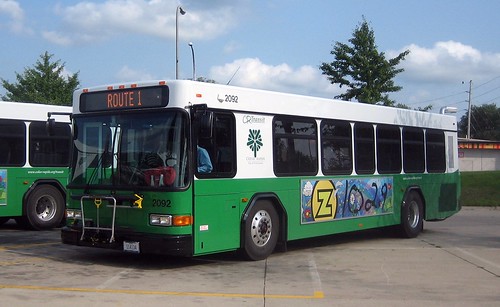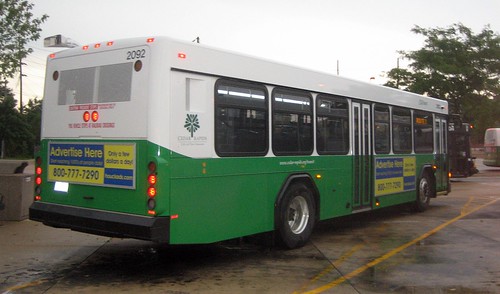The second CR Transit Study open house was held on Tuesday, October 20. The study is being conducted by SRF Consulting Group and Bourne Transit Consulting to analyze the current system and propose route changes to improve service. Various route options were presented at this week’s open house. The consultant’s final recommendations will be presented at a third and final open house on November 24.
During the summer I took a stab at my own hypothetical plan for improving the CR Transit system, developing a nearly complete system of modified and new routes. While my plan was much more idealistic and simply based on my own general knowledge and assumptions of transit operations and Cedar Rapids, I ended up not completing it. My original intent was to create a new route system with multiple transfer hubs – downtown, Lindale, Westdale, and the AEGON area at Blairs Ferry and Edgewood Road NE. My incomplete proposal is seen below. Click the image for an interactive Google map.

Laying out the routes proved more difficult than I figured, because I attempted to maintain similar route distances between hubs so buses could realistically be scheduled to meet at the same time. Using the distance and schedule of CyRide’s main fixed routes (Red, Green, Blue, Brown) as a rule of thumb, I tried to keep each route at around 7.5 – 8.5 miles (in each direction) to correlate to about 35-40 minute of travel. I was also hesitant to remove much existing physical service, even though a big issue with the current system is routes that loop throughout residential streets simply to increase the physical transit coverage without adding addition routes, but at the expense of directness and travel time.
A route hierarchy system was something I tried initially, with a system of four to five high frequency cross-town routes between major hubs, complemented by shorter, less frequent “normal” routes. This was based on Metro Transit’s High-Frequency Network in Minneapolis, with twelve major crosstown routes that operate buses every 15 minutes or less throughout the day. I quickly discovered a hierarchical system would not really work in Cedar Rapids because of its relative compactness (compared to MSP) and low ridership. However, a higher frequency could make sense along certain corridors, such as First Avenue between downtown and Lindale, which is a consistently busy route section already.
Proposed Route Modifications
It was interesting to look at the consultant’s proposed route change options and see how they compared with my own ideas. Generally I agree with most of the proposals and think they will help the system function more smoothly and provide more opportunities for alternative transfer points and route connectivity later on. Each route was provided a minimal modification scenario and a moderate modification. I won’t go through all of them since I wasn’t actually at the open house, and Samantha Dahlby has already written an extensive review on several of the route modifications on her Bus Party blog. However, I would like to comment on Route 3 and the 5’s.

Above is the minimal and “moderate” route modification proposed for Route 3 that was presented at the open house this week. The green represents unchanged sections of the route, red is removed sections, and blue is for new sections. As you can see, the minimal modification is just that, only removing a few small loop sections, but the route stays essentially the same. These minor changes would reduce overall route distance slightly, allowing the bus to run a full trip within 60 minutes without having to fight the schedule. Next, the “moderate” modification is actually quite extreme – it removes the route all together. The justification is low ridership and that a few other routes serve the area close by, including 4, 6 and 5B. Personally I have issues with this because it is the route I’ve used the past three summers to get to work, because it runs right behind my house. The Route 5’s, which run along First Avenue East, is about a five blocks away, which isn’t bad, but it certainly wouldn’t be as convenient. Luckily, I don’t foresee this option being implemented, but we probably won’t be seeing any service frequency increases on Route 3 anytime soon.
Route 5 is currently made up of three separate routes: 5B, 5N, 5S. All three run along First Avenue East from downtown to Lindale Mall, which from there they split into three different routes. 5B serves northern Cedar Rapids and Hiawatha via Blairs Ferry and Boyson roads. 5N (5 North) continues into Marion and loops around the northern half of the city. 5S (5 South) runs through the southern half of Marion. One of the 5 buses departs downtown every 30 minutes, providing half-hour service along First Avenue between downtown and Lindale during all hours of service. But each individual bus only actually runs every 90 minutes, so beyond Lindale Mall, the 5’s only ever run at that frequency.
All of the consultant’s proposed modifications to the route 5’s are past Lindale. I don’t have much to comment on the changes specifically, but ultimately I think the areas served by the 5’s, particularly Marion, would be better served by making the segments beyond Lindale separate routes with individual identification. In my proposal, I had a route running along First Avenue between downtown and Lindale, then connecting routes would run into Marion and north Cedar Rapids. Since the heaviest ridership on the 5’s is along First Avenue between downtown and Lindale, it might be feasible to have a shorter route with an even higher frequency than the current 30 minute headway. Then Marion could be served by either one or two looping routes, providing more frequent (likely 30 minute) service within Marion, with connection to routes at Lindale to go toward downtown Cedar Rapids or elsewhere in the northern area of the metro. Separating the three 5 routes individual would also help avoid the confusion of having three separate routes all numbered 5.
Information and Marketing
Additionally, better information and marketing would help make the system easier to understand and potentially more attractive to “choice riders” – those riders who are not dependent on transit as their primary means of getting around. It is important to make transit information readily available in a variety of mediums: on board, in bus shelters, and online. The only information currently provided consists of individual route maps and schedules, displayed in the temporary waiting room trailer at Lot 44, in pamphlets on board buses, and on the CR Transit website. There is now a comprehensive system map available on the Corridor MPO website, but it is not available directly from the transit website, nor is it available to those without internet access. Graphically it is not very professional or legible. A professionally designed system map needs to be made to improve legibility, as well as public image of the system.
Service stops along bus routes are currently marked with generic bus stop signs that denote which route or routes serve that particular stop. Several stops around town have bus shelters, but they do not display any addition transit information than a stop with only a sign. These shelters would be a good opportunity to improve convenience / user-friendliness by displaying a system map and schedule information for the route or routes that service the particular stop.
Another information improvement would be to standardize and rename bus routes. Instead of just being numbered, each route name should also include the major destinations or endpoint of each route. It might also be helpful to specify the direction of a bus along a particular route when applicable. Another strategy to make routes more identifiable and easy to remember is to assign a particular color to each route. For example, CyRide identifies each route by number, color, direction, and endpoint destination, such as #1 Red East / Mall via Hospital. Since Cedar Rapids has 12 – 14 routes (depending on how you count the 5’s), that may be too many to effectively distinguish each route by color, but including major destinations and endpoint in route titles would be useful. Especially now that CR Transit has four new Gillig buses with programmable LED destination signs, with more coming, they need to be utilized. Right now they only display the route number, providing no information on where it is going or what you connect to from it. (There are a few exceptions – some of the old RTS buses have roller signs with some detail such as “Route 1 – Ellis.”)
Another key part of improving transit and attracting more riders, is to promote the system through branding and better marketing. I don’t mean advertising, but some simple steps to increase visibility and making the system more attractive and user-friendly. A new website, perhaps even with its own URL ( www.CRtransit.com instead of www.cedar-rapids.org/transit maybe?), with useful, easy-to-navigate schedules, detailed maps, and information on transferring between routes would be a helpful resource. Getting on Facebook and Twitter, too, could increase visibility even more, and be used to provide instant service information to riders. These would be relatively inexpensive, yet critical, ways to make transit more accessible and attractive to choice riders – those who are not dependent on transit. Additionally it would finally provide those dependent on the bus system the most basic of transit information.
Like all across the country, more people in Cedar Rapids are looking to transit for an alternative to driving everywhere. Environmental concerns, a renewed interest in urban living, and most importantly, rising gas prices have created a renewed interest in transit and demand for more service all across the country. The Cedar Rapids Transit system has been lacking for years and is long overdue for improvements so it can be a more viable, efficient means of transportation. Now is the right time for us to be planning and implementing initial transit changes, just as we are planning for an even better Cedar Rapids as we rebuild following the flood. The increased public interest, particularly among younger, potential choice riders makes me optimistic for the future of transit in Cedar Rapids. The third and final transit open house will be held November 24, where final recommendations for route changes will be presented.
> CR Transit Study Open House 1 – System Analysis (9/22/09)
> CR Transit Study Open House 2 – Proposed Route Modifications (10/20/09)
 A public hearing will be held at the July 27 Cedar Rapids City Council meeting to consider bus route and schedule changes recommended in the recent Cedar Rapids Fixed-Route Transit Analysis. Any interested individuals or groups are encouraged to attend and speak for or against any of the proposed changes. The meeting starts at 5:30pm and is held in the Council Chambers at Hiawatha City Hall.
A public hearing will be held at the July 27 Cedar Rapids City Council meeting to consider bus route and schedule changes recommended in the recent Cedar Rapids Fixed-Route Transit Analysis. Any interested individuals or groups are encouraged to attend and speak for or against any of the proposed changes. The meeting starts at 5:30pm and is held in the Council Chambers at Hiawatha City Hall.




